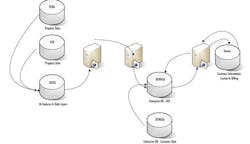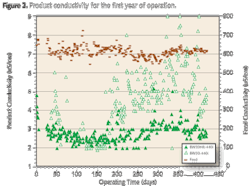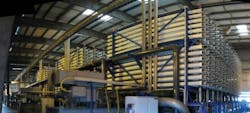Sustainable Solutions Help Low-energy Desalination Power Ahead
With governments across the world considering desalination plants as large as 500MGD, technological improvements and renewable power will be key to help bring down operation costs and improve energy efficiency. Randy Truby and Miller Truby look at progress to date and the potential of osmotic power.
Graph of SWRO costs as calculated by the Affordable Desalination Collaboration
Since 2000, there has been a boom in seawater desalination on a global basis and a growth rate of 25% per year has been realised. This boom has seen desalination spread from the energy-rich Middle East to locations around the world.
Desalination trends and large capacity systems
The emergence of seawater desalination and its success has been driven by a number of factors: large capacity systems – 30 million gallons per day (MGD) (120,000 cubic meters/day) and larger – have helped lower the cost of water; improvements in energy recovery technology have lowered energy consumption; improvements in thermal desalination processes have resulted in greater efficiency and membrane flow and salt removal advancements have improved reliability and water quality. Prior to the year 2000, a 5MGD seawater desalination system was considered large. It was around the year 2000 that contracts were let for four desalination systems sized 25MGD and larger in Singapore, Trinidad, Fujairah and Tampa, Florida. These plants lowered the cost of water significantly, and numbers like $1.71 per 1000 gallons of potable water were reported. Cost reductions due to economy of scale were cited.
In the following years, an additional number of large-capacity desalination plants have been built or are under construction. These additional plants include Ashkelon, Israel, which is approximately 85MGD, and Maacta in Algeria, which will be 132MGD. Today, seawater desalination plants as large as 500MGD are being contemplated and some government organisations are already planning for this reality.
Energy Consumption
Seawater desalination using membranes (reverse osmosis) was first introduced in 1978. Early systems consumed approximately 10 kW-h per cubic meter of water produced (40 kW-h per 1000 gallons) and did not use energy recovery. In the 1980's pelton wheels and reverse running pumps were used to recover energy from the concentrate (brine) stream. These devices reduced energy consumption to about 6 kW-h per cubic meter.
In the late 1990s, isobaric energy recovery technology was introduced. These high efficiency systems recover over 95% of the energy in the concentrate stream. Energy usage is now down to 3 kW-h per cubic meter and, in some cases, even less. These energy recovery systems have thus lowered the energy consumption of a typical seawater desalination system (membrane) by over 70%.
The efficiency of energy recovery systems has had a major impact on the overall costs of water from a membrane desalination system. In the early 1980s, the City of Santa Barbara in California contracted for water at a cost of over $1900 per acre foot. Current water costs at sites like Carlsbad in the same state is less than $800 per acre foot. The reduction in energy consumption has lowered the overall cost of water from a typical seawater desalination plant by about 60%.
Thermal process efficiency and membrane improvements
Thermal seawater desalination consumes about two times the energy compared to a typical membrane plant. For this reason, membranes are preferred for many new and planned installations. However, improved designs in large scale multiple effect distillation (MED) plants have proven more energy efficient. When treating difficult seawater such as the Arabian Gulf where the salt content can be more than 45,000 ppm and the temperature can reach 40C, MSF and MED plants are often selected for their reliability and durability.
Membranes have improved dramatically since first being used for seawater desalination in 1978. The current thin film polyamide membranes produce water at 800 psi (instead of 1000 psi) with a flow of 9000 gallons per element per day (as opposed to 5000 gallons per day). Additionally the membrane area that can be incorporated into an 8 inch diameter by 40 inch long spiral wound element (the standard module size used in large desalination systems) has increased by over 70%.
Salt removal was originally about 98.6%. Today 99.8% salt removal elements are available, and a typical system loaded with these membranes and operating at 25oC and 45% recovery would remove over 99.4% salt.
Membranes have also been enhanced to remove problematic impurities such as Boron. Originally 80% Boron removal was typical. Today it is possible to remove 95% Boron. This is important when the water will be used for irrigation, as many plants are sensitive to Boron above 0.7 ppm. The net impact is that a typical membrane now makes three times as much water at 25% lower pressure and produces drinking water with one-third the salt content.
Sustainable partnerships
In 1980, the University of Iowa in Ames designed and operated a 10,000 GPD seawater desalination system using membranes powered by photovoltaic solar cells. Other scientists have demonstrated that this solar-powered desalination combination will work. However, the capital cost of the solar system in these early designs was high enough to discourage wide scale application.
In Australia, too, a seawater desalination system is combined with a large wind power facility.
It is clear that the desalination process can be powered by renewable energy. The reduction in the energy consumption of state-of-the-art desalination systems has lowered the gap between what renewables can accomplish and the energy demand of desalination.
When reverse osmosis was first introduced, it was theorised that osmotic pressure might be captured to create energy. This theory is now being reduced to practice. The goal is to employ membranes to produce energy. It is further envisioned that osmotic power could produce some of the energy that is required to drive other membranes that are desalinating seawater. WWi
Author's note:Randy Truby is the comptroller at the International Desalination Association (IDA) and Miller Truby is special technical program coordinator with the IDA Young Leaders Program. A conference organised by the IDA: "Desalination: An Energy Solution" will be held on September 8-9 in Huntington Beach, California, USA. Please visit www.idadesal.org for more details.
More Water & WasteWater International Current Issue Articles
More Water & WasteWater International Archives Issue Articles



